6 Strategies to Achieve Successful Work-Life Balance
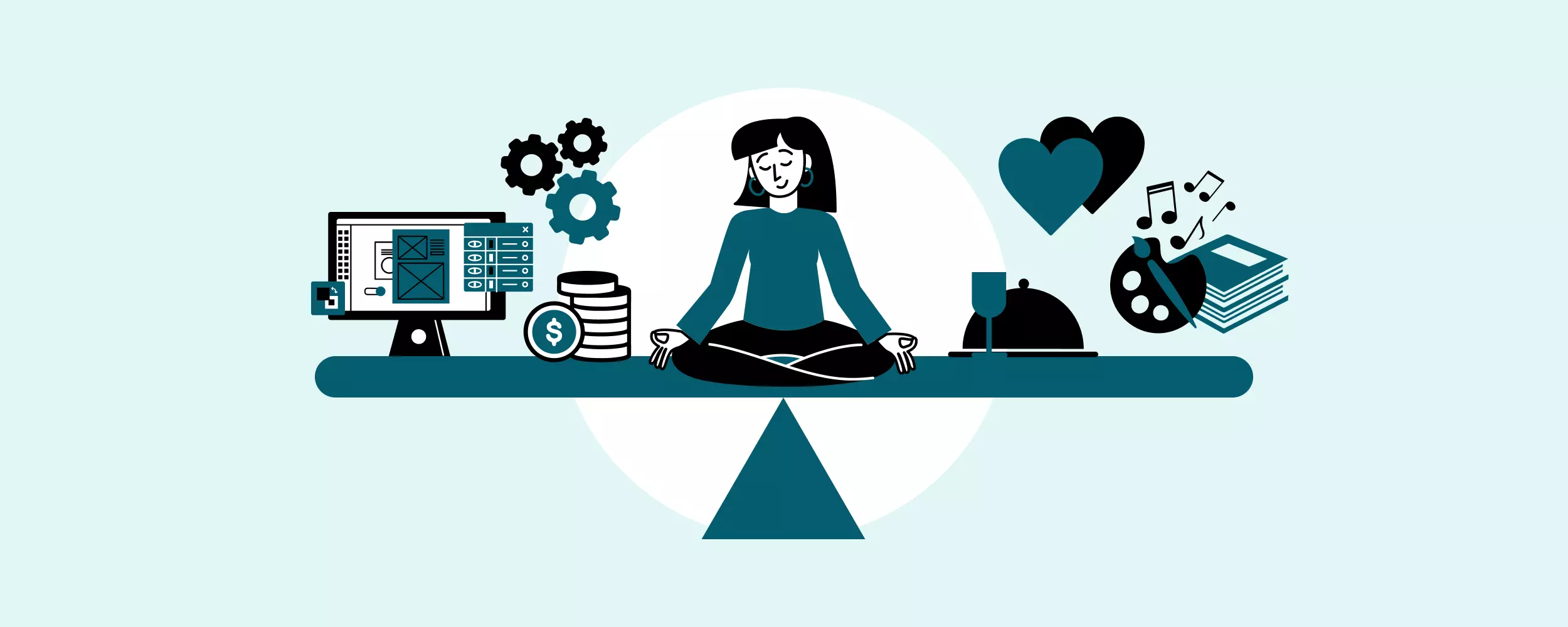
When work is your life and your home is your office, how do you balance your personal well-being and your career? A few work-life balance strategies may help.
If it's all work and no play, it's hard to feel satisfied with life. And if your job is the only thing that brings you joy, the constant pressure of producing results will drive you to burnout.
This doesn't sound like a fun future. So, let's explore some of the issues that cause imbalances and what you can do to counteract them. That is if you're not burnt out already.
Am I Burnt Out?
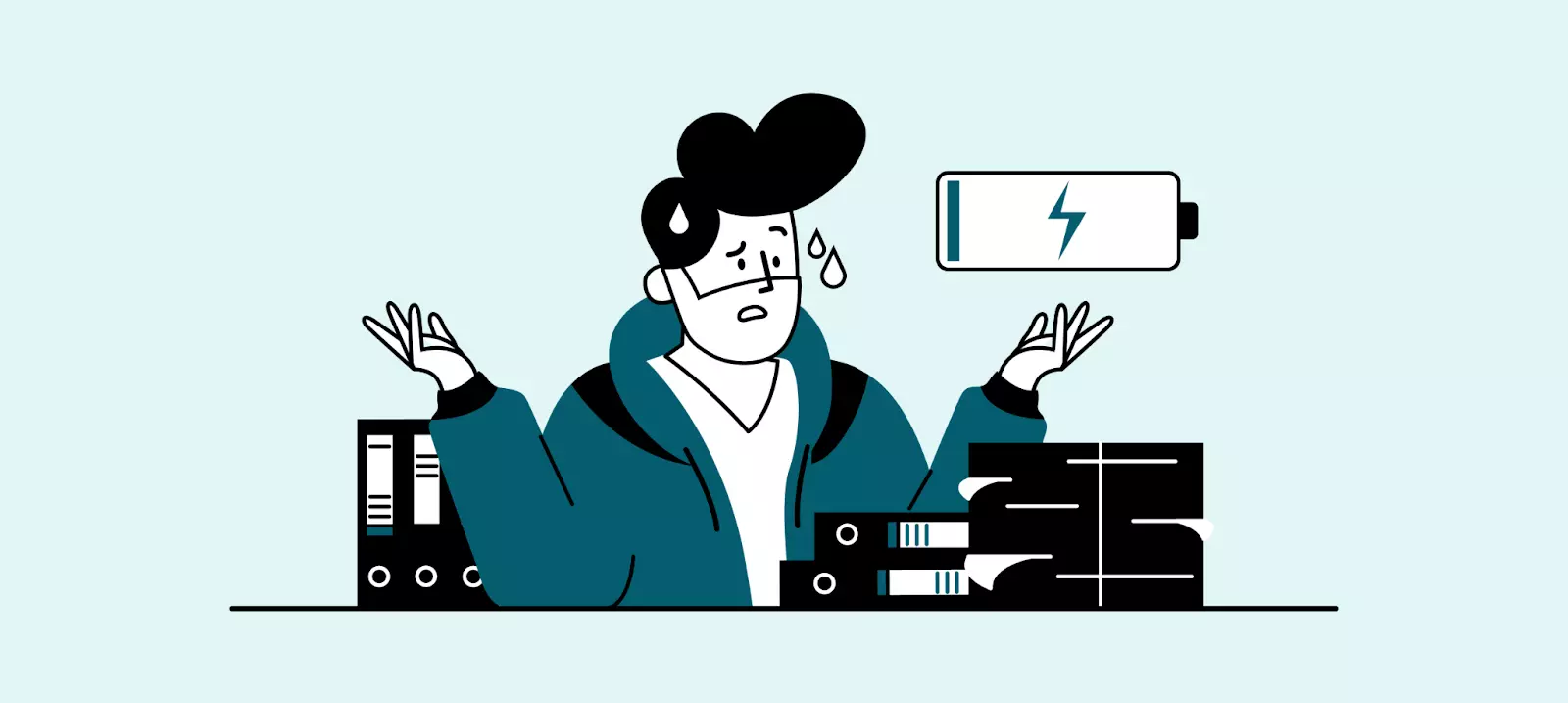
Burnout is physical and mental exhaustion that interferes with your life, disrupts your satisfaction in day-to-day activities and hobbies, and hinders work productivity.
The biggest contributor to this is a work-life imbalance that causes prolonged stress. This can hit close to home for everyone, but especially for those who are self-employed, entrepreneurs, and managers where relentless stress is part of the job description.
Stress is impossible to avoid completely because it's a key factor in the human ability to adapt to different circumstances. The problems arise when you lack resilience and have trouble bouncing back from an uncomfortable event.
Issues also arise if you've been under pressure or stress for a long time because you don't get enough sleep, eat on the go, lack time for things that bring you joy, skip physical exercise, or a hundred other reasons.
But what leads you down the road to burnout? Let's cover some of the common warning signs and consider tactics for prevention.
6 Warning Signs of Burnout and How to Counteract Them
Part of having a steady work and life balance is noticing the warning signs of burnout and making changes at the right time. Here are some of the most common ones and actions you can take to counteract them:
| You Feel Physically Run-down |
|---|
| Warning Signs | How to Prevent or Improve This State |
|---|---|
| It's easy to dismiss physical symptoms as non-stress related, but stress, although typically seen as a purely mental state, actually has many physical side effects, such as: | A 180-degree habit change might not be practical for you, but small steps are valuable! |
| - You're ill a lot and break out (if you're prone to skin issues). | - Write a food diary from time to time to make sure you get all the vitamins you need to maintain a good immune system and hormonal health. |
| - You feel tired despite having enough sleep. | - Reduce your screen time before bed so it doesn't affect your sleep hormones and melatonin. |
| - You have trouble digesting food. | - Have a bottle of water on your desk to hydrate and help digestion. |
| - You generally feel under the weather. | - Take a few minutes every day to consciously unclench your jaw and straighten your back to reduce physical stress. |
| Your Inspiration Is Gone |
|---|
| Warning Signs | How to Prevent or Improve This State |
|---|---|
| Burnout is about lacking positive, and sometimes even negative, feelings. You might lose motivation to do anything and with this comes symptoms, such as: | The key to rediscovering your inspiration is long-term changes; quick fixes won't change your life for the better. Here are a few things to get you started: |
| - Your enthusiasm to get up and start working on tasks is virtually non-existent. | - Find an assistant to help with some tasks and admin so you don't have to worry about every aspect of your job. |
| - You're on autopilot and don't feel inspired by what usually lights a fire in you. | - Make time for activities you enjoy. Happy hormones can bring your inspiration back. |
| - You feel bored all the time and nothing gives you a feeling of satisfaction. | - Find meaning in every task you do. For example, think about how completing it will benefit you because it's easier to feel motivation if the job at hand is valuable to you. |
| You Have Poor Quality of Sleep |
|---|
| Warning Signs | How to Prevent or Improve This State |
|---|---|
| It seems logical that if your energy is low, you should fall asleep easier. On the contrary, constant stress and long hours online can affect your sleep patterns and the quality of the recommended 7-8 or even 10 hours of sleep. This can result in symptoms such as the following: | Scientists still aren't 100% certain why we fall asleep. Yet they do agree that a lack of sleep causes a multitude of problems. The following techniques can help you find a permanent solution to your sleeping problems: |
| - You are absolutely exhausted, but sleep just won't come. | - Keep an energy diary to track when you are best at working and when you get distracted the most to use your time more efficiently. This way you can work at your own pace without driving yourself to exhaustion. |
| - You've tried everything from lavender oil to counting sheep, but your body is just not cooperating. | - Create a routine that will steadily get you ready for work and sleep. The issue might be that you don't get to unwind after work. |
| - You're oversleeping and still feel like you haven't slept at all. | - In this case, it's best to consult a physician, because it could be a sign of a medical problem or depression. |
| Time off Is Difficult to Enjoy |
|---|
| Warning Signs | How to Prevent or Improve This State |
|---|---|
| Worry and anxiety do not respect boundaries; they don't know that it's a Saturday night and your best friend's birthday. Common signs of this are: | Work is not your whole life and personal time isn't a reward. It's impossible to talk about the importance of work-life balance if you don't allow yourself both. |
| - You might be worried about approaching deadlines and missing them, and you feel like you don't deserve a break. | - Even if you work alone or you feel all the responsibility is on you, you're still allowed a break, so practice mindfulness and being in the moment. |
| - You check emails and notifications even during your time off. | - Try Mailbird's 'Snooze' and 'Send Later' features so you don't lose track of what's going on and know that the work can be dealt with at another time that suits you. |
| It's Difficult to Concentrate |
|---|
| Warning Signs | How to Prevent or Improve This State |
|---|---|
| Being constantly under pressure at work, personal matters, and other responsibilities can easily sap your concentration. Your mind simply can't grasp onto one thing. For example: | A good long rest can help with a lot of issues, including troubles with concentration. But taking more than a couple of days off isn't always possible. So try some of the following: |
| - You're meant to be working right now but can't bring yourself to anymore. | - Work in short intervals, like the Pomodoro method suggests. |
| - You drift off, even in meetings that you're meant to be participating in. | - Take 5- to 10-minute breaks every hour or so. |
| - Your tasks take longer to do because you can't retain any information or maintain focus. | - Keep your task manager open during working hours to make notes about your work, such as steps for completing a task. If you're using Mailbird, it integrates with Asana, Trello, and Todoist, so you can manage your emails and tasks in the same interface. |
| You spend all your time working but feel like it's not enough |
|---|
| Warning Signs | How to Prevent or Improve This State |
|---|---|
| When you've lost motivation and it's hard to concentrate on your tasks, it's also difficult to see the value in your work. This may create a feeling that you're not doing enough. | What the hustle culture would call lazy is actually your body telling you that it needs a break. But doing your work diligently is also important. Here's how you can ensure that you're doing what the tasks at hand demand: |
| - You have 12 different notification sounds for all the apps you have to keep open 24/7. | - Reduce the amount of background noise you've got going on, like email notifications and useless newsletters. |
| - Your brain also feels like it has a million tabs open at once. | - It's impossible to finish everything in one day because there's always new work incoming. So, write down a to-do list according to your deadlines. |
| - Everything is urgent, nothing can wait, and everything needs to be done NOW. | - Prioritize work that's most relevant for the day, and focus on completing what's scheduled. |
With the volume of responsibility hanging over your head, physical and mental issues like poor concentration, lack of inspiration, and illnesses are bound to creep up. This could result in you canceling your work and life altogether.
But remember that you don't have to say yes to everything. The people around you should want the best for you, so they will understand some cancellations here and there. To balance work and life, your work and your life have to integrate.
It's not so much about trying to keep work and life separate, but more about keeping their interaction civil. A way to do this is by identifying tasks and processes that slow you down and building new habits to stump those time-wasters.
How to Streamline Different Processes and Save Time
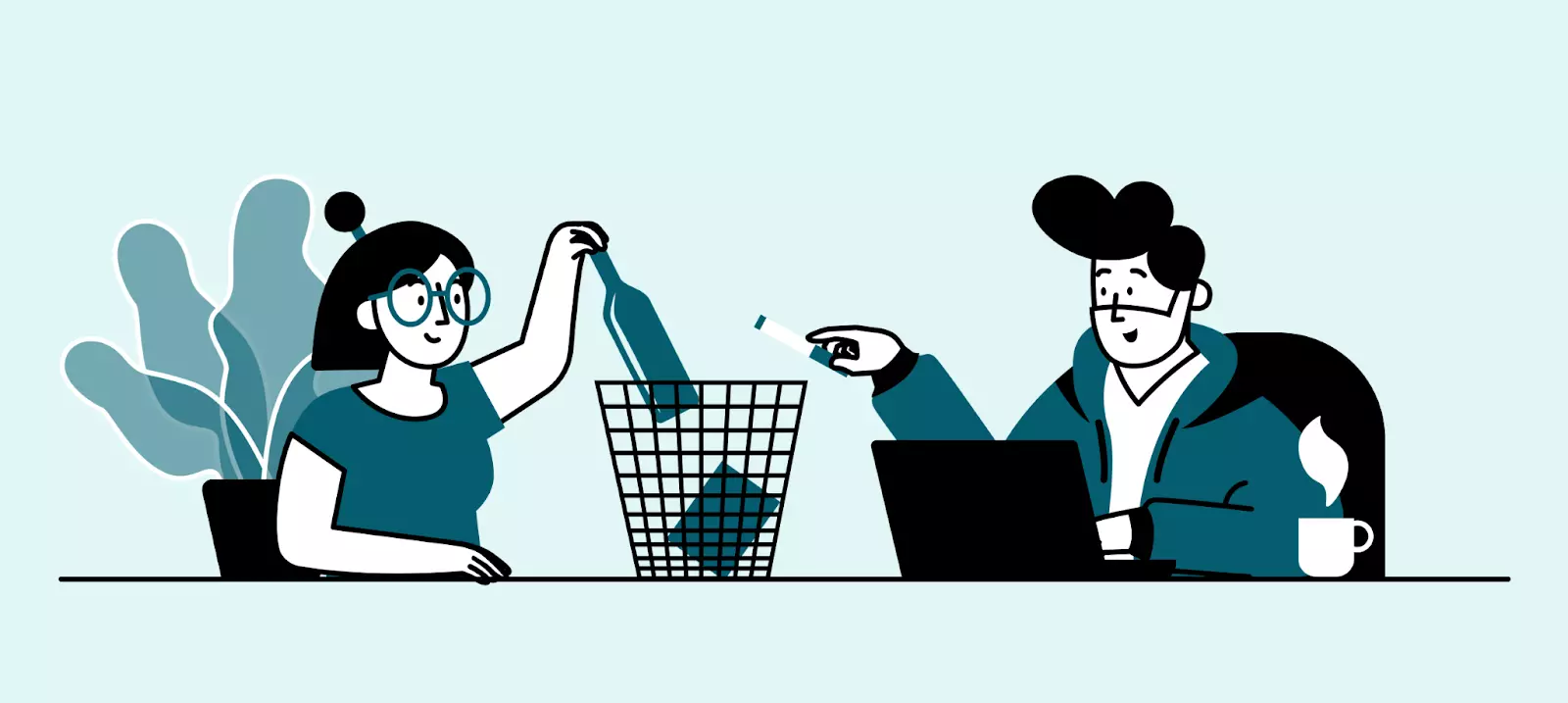
Time is the most precious resource. If you can't take even a five-minute break to close your eyes and breath without your mind constantly jumping into work mode, you'll burn out quicker than you think.
While one side of the coin is an inability to rest, the other one is long work hours and little results.
We've covered quite a few cases that signify you need to pay more attention to your mental and physical well-being. The following are ones that show you may need to consider the way you approach tasks.
| Using Several Email Accounts to Do One Job |
|---|
| Habit That May Slow You Down | Steps to Fixing the issue |
|---|---|
| It's common to have more than one work account if you work on different projects, but don't use them interchangeably to communicate with the same people. This might confuse your clients and colleagues, and you also risk losing track of conversations and threads. | 1. Maintain contacts lists per project so you don't email the same person from different addresses. 2. Use Mailbird's Unified Inbox to keep all conversations in one place. This way, you won't need to skip from one inbox to another. Rather choose the address you want to use in one interface. |
| Using All the Messengers at Once |
|---|
| Habit That May Slow You Down | Steps to Fixing the issue |
|---|---|
| Being present in a variety of messengers makes you available to more clients and business partners, but having all of them open and bombarding you with notifications is likely to distract you. | 1. Stick to the most popular messengers your clients use. 2. Choose one messenger for communicating with colleagues. 3. Integrate messengers with your email app. In Mailbird, you can use Facebook Messenger, Skype, Slack, WeChat, and WhatsApp in the same interface as your inbox. This saves the time spent on switching between different apps. |
| Using Different Calendars to Manage Your Schedule |
|---|
| Habit That May Slow You Down | Steps to Fixing the issue |
|---|---|
| Having more than one calendar makes it more likely that meetings will clash and that you'll lose track of your workload. | 1. Keep your work and personal agenda in one online calendar so you can have access to your schedule at all times. 2. Use color tags to distinguish between different types of events, such as work meetings and birthdays. 3. Try Mailbird's native calendar which unifies all events you have scheduled in different accounts, color-coding each separate calendar. |
| Using Different Go-To Apps |
|---|
| Habit That May Slow You Down | Steps to Fixing the issue |
|---|---|
| You do need a toolset to be effective in the digital world, but using more than one app in a category may be excessive, confusing, and a waste of time, especially if it's within your own network. For example, using Asana and Trello for different types of tasks may result in you losing track of your workload and deadlines. | 1. Choose one tool for each category of tasks (e.g., task management, calendar, email client, SEO tool, CRM system) that suits most of your needs and stick to it. 2. Check out Mailbird's list of integrations. There are probably a few you work with, and using them in one interface along with your email will minimize the distraction of jumping between apps and browser tabs. |
You can find more habits that prevent you from working effectively and finding time for yourself if you do a self-analysis of your performance. Set some time aside for this assessment and audit a week's worth of tasks, for example.
You can ask yourself questions about each task like:
- How well did I do on this task?
- What helped me achieve a good result (e.g., tools, skills, colleagues)?
- What prevented me from achieving a good result (e.g., lack of information, distractions)?
This will help you identify any gaps in your work routine, such as a lack of the right tools, which may be distracting you from your main goals. And then you need to find solutions.
Key Factors in Changing Your Routine to Promote a Healthy Work-Life Balance
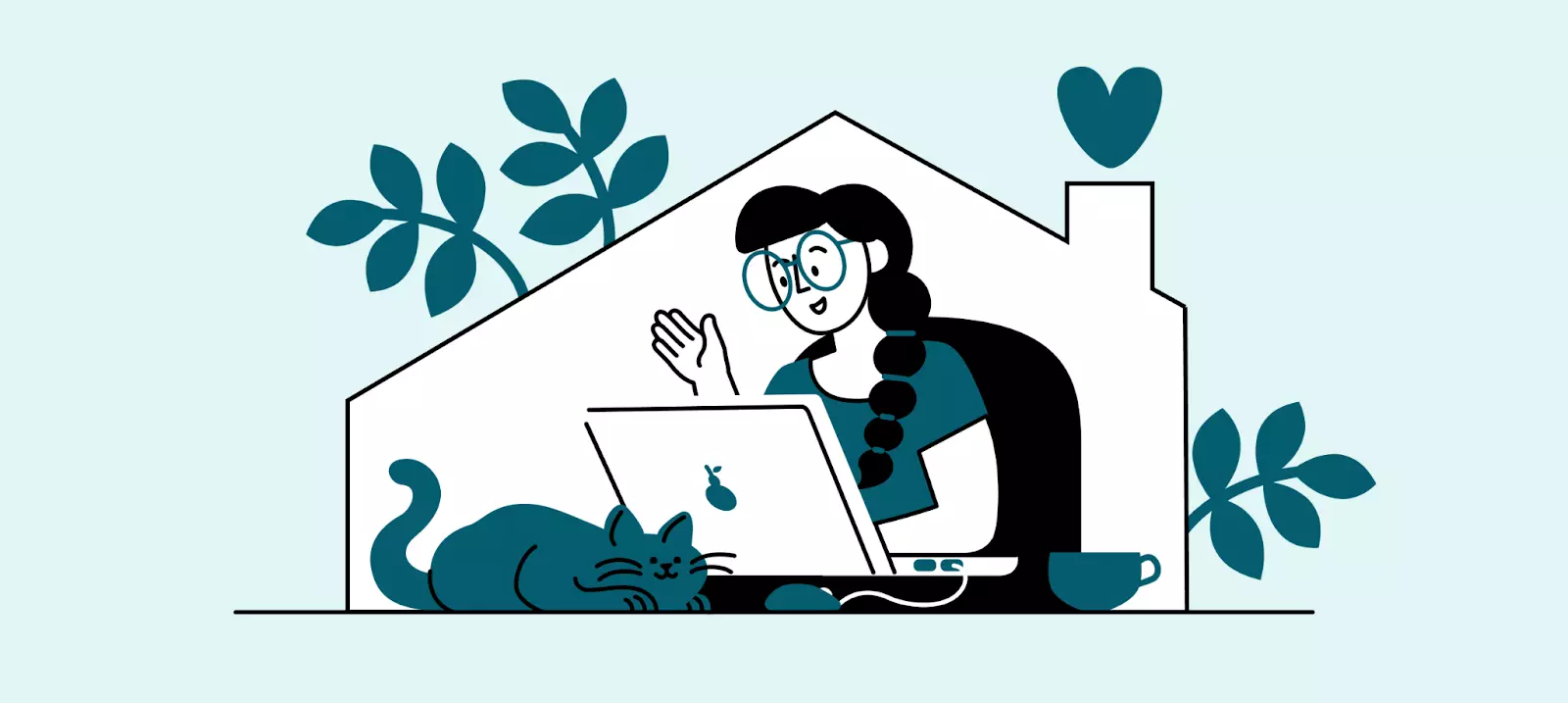
Identifying your problem areas and finding solutions is a huge step forward. But change doesn't happen overnight.
In fact, it's better if it happens incrementally so you have time to adjust - radical life alterations may not produce the long-lasting results you want. So let's go over some factors that will ensure your work balance strategy has a positive result.
1. Being Consistent in Your Efforts
Research shows that it takes a certain number of days to build a habit. A 2009 study from the European Journal of Social Psychology found that people need anywhere from 18 to 254 days to establish an automatic habit - more than two months on average.
You may need more or less than 60 days, depending on the type of habit you want to automate, your personality and circumstances, and how enjoyable it is. But most importantly, it's about how consistent you are about implementing it.
Say you want to start doing a morning routine to kickstart your day. If you do it once a week, chances are, you'll forget the steps by week two. Instead, doing it every other day or every workday will give you a steadier result.
A few tips that can help with consistency:
- Write down what your routine consists of;
- Make sure it's sustainable (e.g., light exercises instead of a 5-mile run); and
- Add the routine to your calendar as a recurring reminder.
2. Practicing Time Awareness
A desired and achievable deadline may be two very different figures. Whether it's you, a boss, or a client who wants something done in a constricted time frame, constantly running out of time is discouraging and stressful.
It's a good idea to allocate more time to tasks than you think they will take and complete them quicker, exceeding expectations. But don't count on this strategy forever because people start looking forward to receiving results sooner.
A few tips for improving time awareness:
- Use a timer to calculate how much time you need for different types of tasks;
- Keep note of distractions that made you forget about the timer; and
- Try the Pomodoro method - splitting work into 25-minute work and 5-minute break increments with a longer break after four pomodoros.
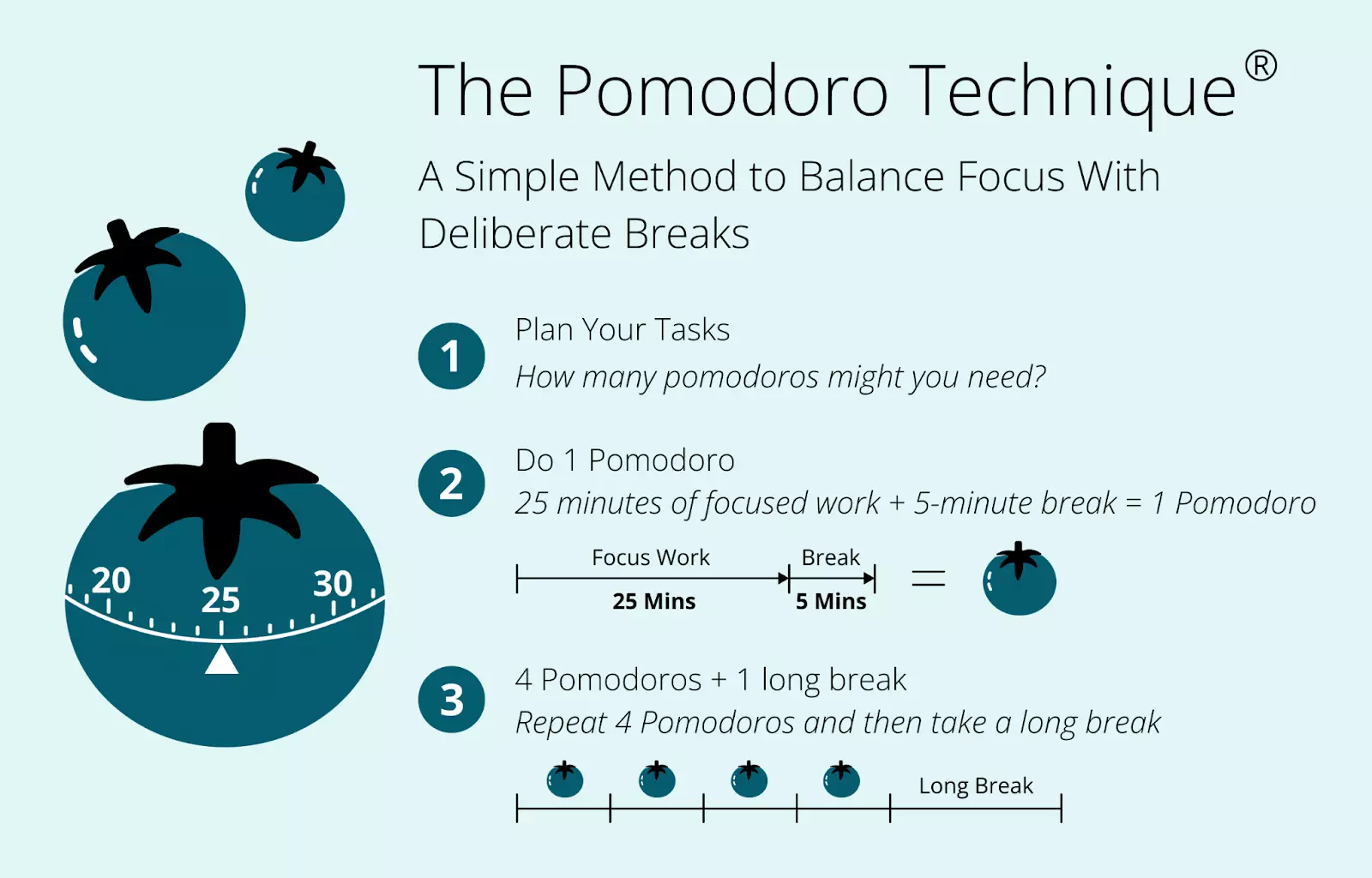
3. Creating Personal Boundaries
If work finishes at five, it finishes at five. This means that you have dedicated 6-8 hours of your day to work and what comes after that shouldn't be haunted by thoughts of incoming emails and new tasks.
There's a condition though. If you decide to work for eight hours, you don't stretch it to 10 just to get more done.
A few tips to keep work time separate from the rest:
- Separate your workplace from drinks, meals, and leisure, especially if you work from home;
- If you only use your computer for work, power it off and forget it exists till the next workday; and
- If you have a client or colleague in another time zone, use the schedule email option to send messages at an appropriate time.
4. Saying No More Often
FOMO (Fear of Missing Out) is a 21st-century problem that has arisen due to the abundance and accessibility of information. When you're surrounded by opportunities, it's hard to say no for fear you might lose out on a great one.
But it's necessary. For example, there's a networking event that you don't really want to attend, though you may meet potential clients. Pushing yourself a bit is okay from time to time; however, if you're feeling run down, the best choice would be to go home and take a nice relaxing bubble bath.
A few tips to find a yes-and-no balance:
- Learn to separate real opportunities from pure FOMO by weighing out the pros and cons and putting your well-being first.
- If there's a potentially important event but you have no energy to attend, delegate it to employees or colleagues.
- Try changing your perspective about saying no - it means being thoughtful about the value of things, instead of assuming you're being lazy or selfish.
5. Enjoying Yourself
Find new hobbies, really enjoy your time with family and friends, and cherish your down time with yourself. If you make time for work and play, both interact for your enjoyment and productivity.
There's also a practical aspect for having different hobbies - they give you more ideas for conversations because limiting all talk to business can become boring.
Think of it as a bounce rate. If a user is interested in content, he/she will spend more time on your website. If you're interesting to clients and potential partners, they will spend more time talking to you. It's more likely you will get a deal this way.
6. Practicing Mindfulness
Too much stress is bad for business because it leads to poor physical and mental health. It's easy to make mistakes when you're exhausted and unmotivated.
The practice of mindfulness is being aware of your actions, feelings, body, and the state of your mind. Listening to yourself can help you know your symptoms and prevent burnout.
Final Thoughts
Work-life balance strategies can be divided into two major parts - preventing burnout and improving time efficiency. One is about keeping your personal matters in check, resting, and enjoying life. The other is about keeping work matters within the boundaries of business hours, which means using this time more efficiently via soft skills and an appropriate toolset.
Mailbird can be a part of this toolset because it has time-saving features for email, calendar, and contact management. It also integrates with many popular business apps. And you can try all this for free and discover how useful it is when it comes to establishing a healthy work-life balance.